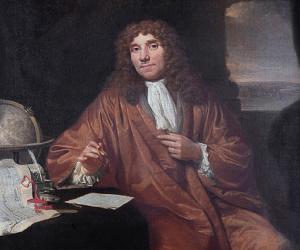
Important advances in microbiology were made by Antony van Leeuvenhoek (1632 – 1723), which include a substantial improvement on the microscope followed by the discovery of a variety of single celled organisms.
Antony Van Leeuvenhoek was for his time an unusual candidate to make breakthrough scientific discoveries. He earned no university degrees and therefore had no formal scientific training, and he was not particularly wealthy. His trade was that of a textile merchant that led him to develop improved lens in order to better observe thread quality. He cultivated in himself a tremendous skill in lens making with some of his lens being able to magnify up to 300 times and possibly higher, which was a significantly higher level of magnification than the compound microscopes of his day that only magnified around 20x – 30x. During his lifetime he may have made over 500 magnifying lenses.
He used these lenses, along with his terrific eyesight and observational skills, to observe the first bacteria. Through a friend he communicated with the Royal Society through dozens of informal letters, and although the Society was originally skeptical of his claims they were later verified by Robert Hooke and others. This led to his election into the Royal Society in 1680 and bestowed on him a tremendous amount of fame.